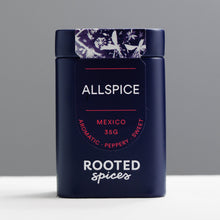- INFO
- WHERE
- RECIPES
- STORAGE
- HEALTH
This underused spice lives up to its name. You get so many flavours for the price of one – a heady mix of nutmeg, peppercorn, cloves, cinnamon and juniper berries.
It was hugely popular during the Middle Ages, when allspice would spice meats and spike mulled alcohol. It’s a spice which is starting to crop-up again in more recipes, and it's no surprise. Allspice works in sweet and savoury dishes, acting like an instant blend and packing a real punch.
The spice originated in the West Indies – where it’s used in jerk seasonings – but it’s long been traded along historic spice routes appearing in Ethiopian (berbere) and Middle Eastern (baharat) blends.
Though we usually recommend buying whole spices over pre-ground, allspice is dried until bullet hard, and needs industrial grinding to achieve a fine grade. This tin of pre-ground allspice lends itself to easy experimentation: fling a little in a spiced beef stew, season pulled pork or use a pinch of allspice to lace gingerbread dough, stewed apple and pumpkin pies.
ALSO KNOWN AS: Jamaican Pepper, myrtle pepper, Pimenta Dioica
Allspice is native to the West Indies and Central America. We get ours from Mexico, where the late summer sunshine dries-out the unripe berries, until they are dark and aromatic.
COOK THIS SPICE
Jerk Chicken
Allspice roast chicken with slow-roasted garlic and za'atar yoghurt
Spiced Chocolate Brownies
Saida Sausage Rolls
Syrian Spaghetti with Pomegranate & Lentils
Allspice should be stored in a dark, airtight container, to retain its potency.
Allspice has long been used in folk medicine. In Jamaica, an allspice tea is used to treat colds, menstrual cramps and upset stomachs, whilst in Costa Rica, it is believed to help diabetes.
Scientific studies have been carried out to assess the medicinal compounds contained in allspice berries. To read more, click HERE.






